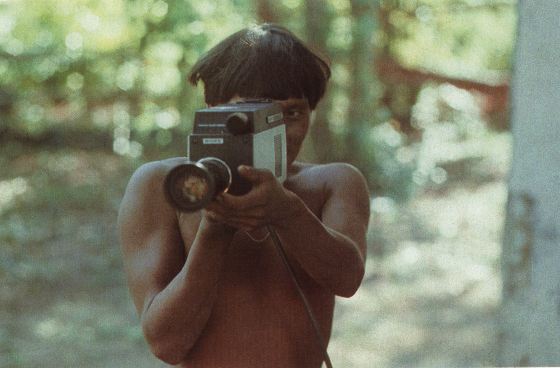Taussig's research and writing has expanded the horizons of traditional ethnographic fieldwork, forming "an inscription on the edge of official history" that weaves together observation, fact and fiction, archival history, memoir and literary theory. He has stated: "an aim of such writing is to turn the attention of the reader to the very act of writing as an 'anthropological' or cultural act which engages with the desire to succumb to authority in general, and to colonial or postcolonial tropes in particular." His highly influential publication Mimesis and Alterity (1993) took the idea of writing as "mimetic exchange with the world" as its core, developing an idiosyncratic history of the mimetic faculty and the interweaving concepts of imitation and difference.
Juan Downey's The Laughing Alligator (1979) was shot while the artist, his wife Marilys and stepdaughter Titi, lived in the Amazon rainforest with the Yanomami people. Extending out of Downey's celebrated Video Trans America series (1973-1977) in which he undertook to produce a videotaped account of a trip from New York to the southern tip of Latin America, carrying with him his camera, generator and monitor and playing back his recordings in towns and villages along the way, the video takes on "objective" methods akin to anthropological research while functioning as a subjective diaristic essay. In his 2008 essay "Feedback in the Amazon" Nicolás Guagnini posits that Downey "did not go only to 'see,' but to see himself seeing as the others were seeing him, realizing a negotiation of otherness in real-time within an actual community. This was his ultimate actualization of video feedback." Downey was trained as an architect, and was particularly interested in the funerary architecture of the Yanomami, who ritually consume the pulverized bones of their dead in a soup. In The Laughing Alligator the artist states he wants to be eaten by the Yanomami "not as an act of self sacrifice ... but as a demonstration of the ultimate architecture: to inhabit, to dwell physically as well as psychically, inside the human beings who would eventually eat me."
Jean Rouch's Les Maîtres Fous (1955) is one of the French director and ethnologist's first "ethno-fictions," a term coined to encompass his blurring of techniques of fiction and non-fiction, between the practices of anthropology and film. Rouch first travelled to West Africa in 1941, working as a civil engineer overseeing a construction project in Niger. He spent the majority of the subsequent sixty years of his working life in the region, collaborating with local filmmakers and actors on films that demonstrated the traditions, culture, and ecology of the people of the Niger River valley. Les Maîtres Fous focuses on the Hauka movement active in the suburbs of Accra, then the capital of the Gold Coast. A possession cult, those participating in Hauka mimicked the military ceremony and gestures of European colonial administrators, in a state of trance. As Rouch explains, "the cult is an African expression of our culture. The title of the film is a pun. The British colonial masters are the ones who are mad." When released the film was considered offensive by both colonial authorities, and by African scholars, filmmakers and students alike.
